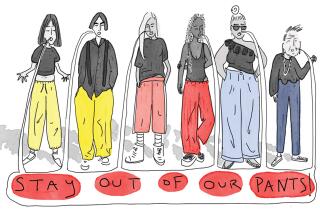Fat Ladies: Food for Thought
There are times when I question my sanity. There I was, feverishly exercising on my Health Rider while watching the Two Fat Ladies cook up dish after dish of cholesterol on the Food Network.
Clarissa Dickson Wright and Jennifer Patterson are the “Fat Ladies,” those motorcycle riding, butter wielding indomitable British matrons who let it all hang out with nary a care for coiffures or cosmetics, much less waistlines. While they sang the praises of “lovely pork fat” and “delightful cream,” I subjected my body to a machine that centuries earlier would have been suitable for the Bastille.
Now, where’s the sense in that?
I suppose the answer resides somewhere in the admission that, despite my devotion to the gods of fitness and fashion, deep down I secretly admire the Fat Ladies. I admire them for their courage to be who they are: free from the ever changing notions of being “becoming.”
The Fat Ladies make no apologies for their abundant padding. With pudgy hands they proffer custard-filled pastries as if to say to their viewers, “A pox on fashion; you’re never going to be a supermodel so just enjoy.”
Oddly enough, I find this rejection of fashion industry images not only apparent in the Fat Ladies, but also mirrored by many of my female students. In fact, I find the slightly masculine, definitely slovenly styles popular among my not-so-thin teenage girls, along with their bobbed, pinned and gel-plastered hairstyles, to be a fashion statement against fashion. Many girls, who by the Twiggy standards of my youth would be considered overweight, appear proud of their healthy accumulation of baby fat. Apparently, both the Fat Ladies and pleasantly plump girls are growing in popularity.
Many fitness buffs and health care providers sound the alarm concerning the health risks awaiting overweight teens. I wonder, though, if this lapse in weight-watching among our teens isn’t a corrective to my generation’s “Barbie doll” brainwashing. Tragically, then as now, anorexia and other eating disorders are all too common among teenage girls. Yet among the students I teach, girls seem less obsessive about their weight and body image than a generation ago, even though there is no shortage of surgically enhanced models of feminine beauty. TV shows such as “Xena: Warrior Princess” and “Buffy the Vampire Slayer” are favorites among my students.
They seem, however, to relegate these shows to the comic world of make-believe. I don’t sense any real desire to emulate these plastic images of feminine beauty. Instead, my students’ notions of style and body image seem to mimic the “abandoned waif” look made fashionable by singers such as Alanis Morissette.
*
Although many adults may disdain the slovenliness of America’s youth, I hope we will not impose on them rigid standards of what it means to be attractive. I hope we will teach our children to love the human form in all its wondrous shapes and sizes. Unlike myself at their age, I hope my students will not spend their youth loathing their bodies because they are never “just right” when compared to commercial images of beauty.
Naturally I’ve matured beyond the edicts of fashion and I now adhere to diet and exercise under doctor’s orders . . . purely medicinal, you understand. As for the Two Fat Ladies, they whet my appetite to indulge in something other than vanity. They remind me that eventually, time will weigh heavily upon us all.
So, “Eat, drink, and be merry for tomorrow you may die,” or, at any rate, look something very like the Fat Ladies. Ah, but for the love of those luscious Rubens (Peter Paul, that is, and hold the dressing).






